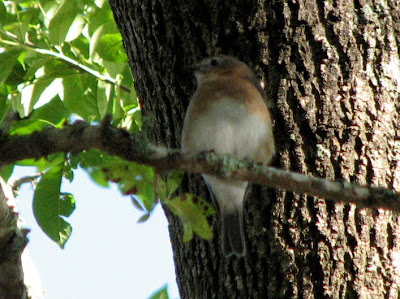I had a free 90 minutes yesterday morning and so I jumped into the car and headed over from the college to Bear Creek Park in hopes of seeing a Vermilion Flycatcher. We're well outside the normal range of this stunning bird, but an adult male has wintered on the Bear Creek golf course for the past six years and was spotted there again the other day.
At 9:20 I turned onto Golf Course Road and parked where I could see the area where the flycatcher always hangs out: the trees around the water hazard near the ninth hole.
By 9:30 I was feeling frustrated and antsy. I kept seeing patches of bright red in the trees but I was too far away to tell if I was seeing the flycatcher or a Northern Cardinal or just some brightly colored leaves. It didn't help that the light was poor and that I'd left my good binoculars at home and was using a cheap old pair that I keep in the car.
So I gave up on the flycatcher and drove into the park proper to bird N. Golbow Road.
We've had a lot of rain lately and large areas of the park were flooded. (As the local constable put it when he pulled up beside me for a chat, "You just have to pee in Bear Creek and the whole park floods.")

Many of the minor roads were closed to vehicles ...

picnic tables had become islands ...

and the restrooms were inaccessible.

I love it when Bear Creek is like this, because the flooded areas usually draw in large numbers of wading birds.
As soon as I started walking along Golbow, I saw several Great Egrets, Snowy Egrets and a Great Blue Heron. There were other birds, too. Carolina Chickadees, Tufted Titmice and Pine Warblers. I spotted a Downy Woodpecker, followed by a couple of Red-bellied Woodpeckers and my FOS Northern Flicker. Then I heard the unmistakeable call of a Pileated Woodpecker. The light was bad and the bird was too high up for a decent photo but the red crest was clearly visible.

A moment later it flew away, to be followed almost immediately by another Pileated.
We only get six woodpecker species in Houston and I'd now seen four of them in only 10 minutes. I decided that it would be really neat to see all six species on one day. Perhaps not quite as thrilling as seeing the "Big Five" mammals in South Africa's Kruger Park three years ago, but definitely worth doing.
So I turned back to where I had parked the car at the junction of Golbow and Dorpslauf Road. The area immediately southwest of the junction is the best place I know for woodpeckers and I was pretty confident that I would see a Red-headed Woodpecker there. The sixth bird, Yellow-bellied Sapsucker, might be tougher to locate but I would worry about that in due course.
I should have known. The very first bird I clapped eyes on was a Yellow-bellied Sapsucker. And at almost the same moment, I heard Red-headed Woodpeckers calling. Seeing the "little six" was going to be even easier than seeing the "Big Five" had been in Kruger.
Ten minutes later I was feeling very frustrated! I could hear Red-headeds calling everywhere around me but I couldn't see any of the birds. They were all in areas that I couldn't reach because of the floodwaters. (I was in my work clothes and it wouldn't do to return to the college looking like I'd been playing in the mud.)
Other birds were being a nuisance, too, by trying to distract me. Downy Woodpeckers, Eastern Bluebirds, Tufted Titmice and an Eastern Phoebe kept popping up on nearby branches and begging me to take their photos. The light was still terrible but I took a couple of photos just to get rid of the pesky little birds.


10:00 a.m. rolled around and still no Red-headed.
Then, at 10:05, I spotted one. No, two. They were too far away for photos but easy to identify. Here's a picture of one from an earlier visit to the same area.

All six woodpeckers in exactly 30 minutes. Not bad at all.
Since I was obviously on a roll, I just had to go back to the golf course to look for the Vermilion Flycatcher. Remember him? He's the reason I came over to Bear Park in the first place.
I sat in the car scanning the area near the ninth hole. There was a Great Egret. There were Killdeer. There was a Loggerhead Shrike. A Double-crested Cormorant flew over. A couple of Turkey Vultures circled above. Fifteen minutes ticked by. And there he was! Perched right on top of a tree, the red of his plumage spectacularly bright against the blue sky. No chance of a photo but, in case you're not familiar with the Vermilion Flycatcher, here's one I photographed in Big Bend National Park last year.

Six woodpeckers and a Vermilion Flycatcher, plus a dozen or more other species in a little over an hour. I love Bear Creek!
2 comments:
I enjoyed your little adventure. Sounds like a great spot. Makes me appreciate the fact that we have Vermilion Flycatchers in most of our city parks in Tucson, AZ, HOWEVER I have yet to see a Red-headed Woodpecker, so there you go.
As we have relatives in Phoenix, we've been to Tucson a couple of times. We loved the desert museum and the saguaro parks. Didn't see Vermilions but saw Roadrunner and Harris Hawks.
Post a Comment